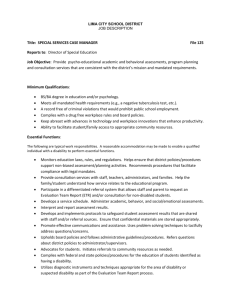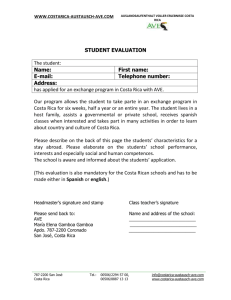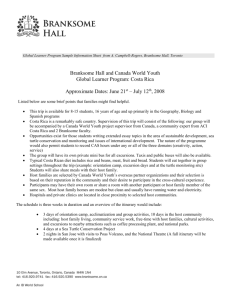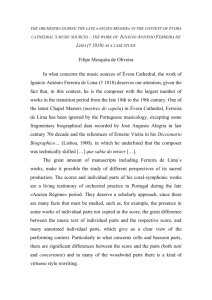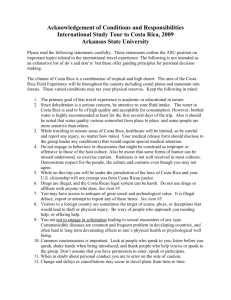class notes - Transport Accident Commission
advertisement
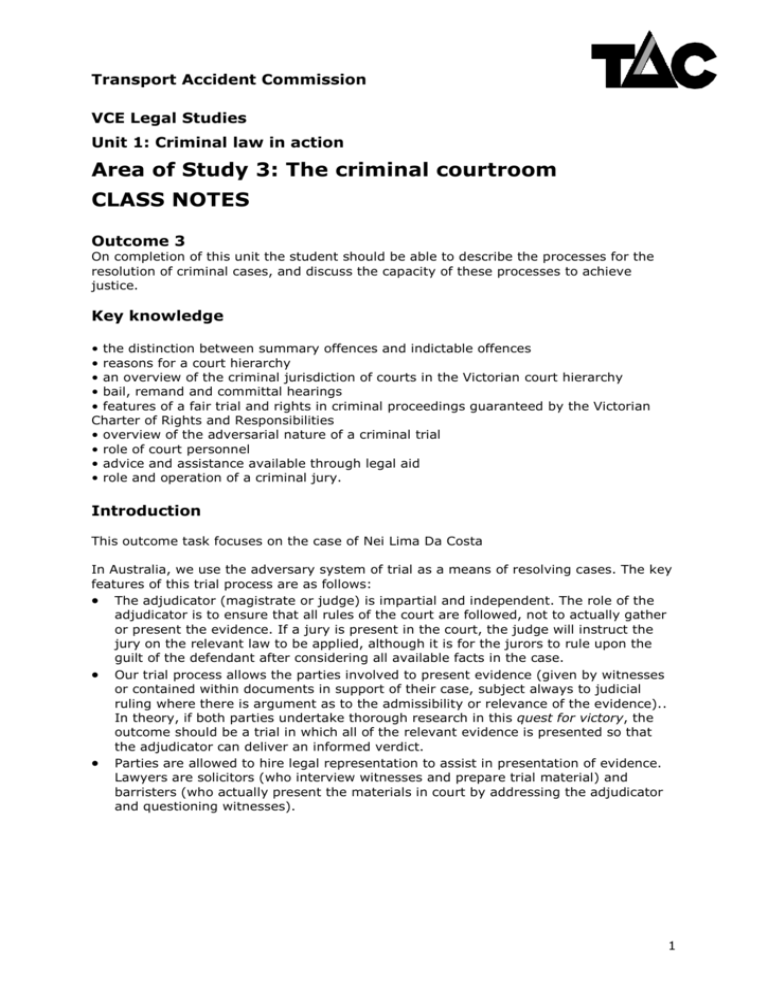
Transport Accident Commission VCE Legal Studies Unit 1: Criminal law in action Area of Study 3: The criminal courtroom CLASS NOTES Outcome 3 On completion of this unit the student should be able to describe the processes for the resolution of criminal cases, and discuss the capacity of these processes to achieve justice. Key knowledge • the distinction between summary offences and indictable offences • reasons for a court hierarchy • an overview of the criminal jurisdiction of courts in the Victorian court hierarchy • bail, remand and committal hearings • features of a fair trial and rights in criminal proceedings guaranteed by the Victorian Charter of Rights and Responsibilities • overview of the adversarial nature of a criminal trial • role of court personnel • advice and assistance available through legal aid • role and operation of a criminal jury. Introduction This outcome task focuses on the case of Nei Lima Da Costa In Australia, we use the adversary system of trial as a means of resolving cases. The key features of this trial process are as follows: The adjudicator (magistrate or judge) is impartial and independent. The role of the adjudicator is to ensure that all rules of the court are followed, not to actually gather or present the evidence. If a jury is present in the court, the judge will instruct the jury on the relevant law to be applied, although it is for the jurors to rule upon the guilt of the defendant after considering all available facts in the case. Our trial process allows the parties involved to present evidence (given by witnesses or contained within documents in support of their case, subject always to judicial ruling where there is argument as to the admissibility or relevance of the evidence).. In theory, if both parties undertake thorough research in this quest for victory, the outcome should be a trial in which all of the relevant evidence is presented so that the adjudicator can deliver an informed verdict. Parties are allowed to hire legal representation to assist in presentation of evidence. Lawyers are solicitors (who interview witnesses and prepare trial material) and barristers (who actually present the materials in court by addressing the adjudicator and questioning witnesses). 1 STUDENT WRITING COMPETITION 2008 There are strict rules imposed in the court that are designed to ensure that only the most reliable evidence is presented. For example, either a direct witness must give evidence (a person who actually saw the events) or an expert who has been hired to assess material gathered at the scene and give an opinion to the court. The Prosecution must comply with the Human Rights Charter and professional codes of conduct. These areas are not covered in this unit of study. Juries are used in the County and Supreme Courts. They are not used in the Magistrates’ Court (the lowest court in the hierarchy), although this court hears over 80 per cent of all criminal offences. The Magistrates Court hears all summary offences (less serious) and some indictable offences (more serious) triable summarily. In comparison, the County and Supreme Courts both have authority to hear the serious offence of culpable driving. In criminal cases, juries are used when an accused person pleads not guilty to an alleged offence. Where a defendant pleads not guilty, 12 people are chosen for a jury. In all criminal cases tried by a jury, the verdict must be unanimous (all jurors agreeing). In limited circumstances, a court may allow a majority verdict (all but one agreeing) if a unanimous verdict cannot be reached. The only time when a unanimous verdict is required, and a majority verdict is insufficient to a finding of guilt, is for the most serious offences such as murder, treason, the more serious driving offences and all Commonwealth offences. Wider reading There are many cases involving charges of culpable driving causing death and dangerous driving causing death and serious injury that have been reported in the media. It is important that students read widely on these cases to expand their grasp of criminal law processes and procedures. An example case, Nei Lima Da Costa, is explained below. Culpable driving case study Nei Lima Da Costa Sources • Driver who struck and killed three people was high on ice, court hears The Age - June 10, 2014 Mark Russell • Speeding driver jailed for 16 years for running red light while high on ice, killing three ABC News on-line - 17 September 2014 Peta Carlyon In June 2014 in the Victorian Supreme Court, Nei Lima Da Costa, 30, pleaded guilty to three counts of culpable driving causing death, three counts of negligently causing serious injury and one count of reckless conduct endangering life. The collision occurred on 12 January 2014, with Lima Da Costa traveling at 120-km/h in an 80- km/h zone. Lima Da Costa, a Brazilian national, drove through a red light and crashed initially into a pedestrian as he crossed the intersection of Warrigal and Dandenong Roads in Oakleigh, a south-east suburb of Melbourne. The light had been red for 18 seconds before Lima Da Costa entered the intersection. The pedestrian died instantly. The car then continued on to collide with another vehicle, killing two of the occupants and injuring three others. CCTV footage was shown in court of Lima Da Costa driving into the Crown Casino car park just after 8pm on January 12, the same evening as the collision that killed three people. Lima Da Costa blocked off an exit in the car park and appeared to fall asleep. Lima Da Costa was woken at 11.18pm by a casino employee, before driving off. It took him just 12 minutes to drive the 14.8 kilometres from Crown Casino to Oakleigh. 2 STUDENT WRITING COMPETITION 2008 After the deaths of the three people, Lima Da Costa told police he had not slept for two days after taking cannabis and the drug, ‘ice’, which is a form of methamphetamine. In September 2014, Justice Lex Lasry sentenced Lima Da Costa to 16 years in prison, with a minimum term of 11 years. In sentencing, the judge said that the crash was "nothing less than a massive tragedy ... In only a few seconds you've done something that affects the life of dozens of people … This was no sudden lapse. It occurred over 14 kilometres of reckless driving on your part." At the sentencing hearing, more than a dozen victim impact statements were tendered to the court and Justice Lasry explained the impact of the crimes on those most affected. Speaking of the drug, ‘ice’, Justice Lasry said, "It now represents a significant problem ... and the drug is at the basis of far too much of the work of this court, and the County and Magistrates Court.” At the sentencing, an interpreter assisted Lima da Costa and it was accepted by the judge that he felt remorse for the crash. The court heard that Lima Da Costa has a long history of drug use in both Australia and in Brazil. While he has a son living in Brazil, Lima Da Costa’s Australian wife was pregnant with the couple's second child at the time of the crash. Lima Da Costa’s legal counsel, Mr Dane, was quoted as saying, "If methamphetamine is at the centre of this tragedy, then the penalties are far too light for trafficking and manufacturing.” Part A Students should research TWO example cases and, for each case, make detailed notes on the following. The case should have been completed in the previous two years a) The plea entered by the defendant b) The key facts of the case c) The nature of the charges against the defendant d) Any evidence given by way of victim impact statement(s) e) The outcome. Part B ‘The sentence imposed in the Lima da Costa case should serve as a deterrent for others not to use drugs when driving’. Respond to this statement in a 400-word response. 3 STUDENT WRITING COMPETITION 2008 ? Assessment task The assessment of these key knowledge areas is in the form of responses to the above questions and the essay, in which students respond to questions drawn from Area of Study 3. In responding to the questions, reference must be made to relevant cases where appropriate. It is expected that detailed class discussion would have occurred prior to the test. The test is available from the TAC Schools website – http://www.tac.vic.gov.au/road-safety/schools/vce-legal-studies. 4


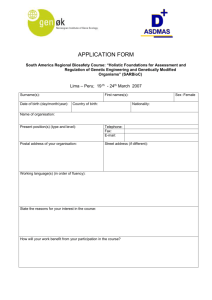
![Alina%27s+biography[1].doc](http://s3.studylib.net/store/data/008053716_1-e26660debd094c135eb326538c217c07-300x300.png)
